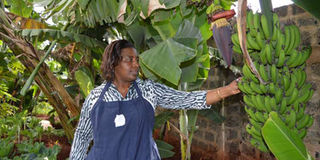Watch out for banana disease giving farmers sleepless nights

Esther Wairimu on her farm in Kiambu. A banana disease, Banana Bacterial Wilt is ravaging the crop in different parts of the country, but mainly in western Kenya, though it is yet to affect farmers outside the western counties. FILE PHOTO | ERIC WAINAINA | NATION MEDIA GROUP
What you need to know:
- The disease was first reported in Ethiopia in 1968 and it affects banana cultivars causing up to 100 per cent losses.
- Outbreak in the region is significant because western Kenya produces over 60 per cent of bananas consumed in the country.
- The disease must be monitored so that it doesn’t spread to regions like Kisii or central Kenya where pruning is practised.
- Ferrying of planting materials from region to region should be discouraged.
A disease known as Banana Xanthomonas Wilt (BXW) or Banana Bacterial Wilt (BBW) is ravaging the crop in different parts of the country, but mainly in western Kenya.
The disease that affects banana cultivars causes up to 100 per cent losses.
The bacterium is known as Xanthomonas campestris pv musacearum and was first reported in Ethiopia in 1968. In 2001, it was found in Uganda and it attacked many banana cultivars.
Since then, it has been spreading. In Kenya, the disease was first reported in 2006 in Teso, Bungoma and Busia. In 2007, it was identified in Bondo, Siaya, Mumias, Butere and Mt. Elgon.
The disease later spread to parts of Emuhaya, Gem, Kakamega and Vihiga.
The current outbreak in the region is significant because western Kenya produces over 60 per cent of bananas consumed in Kenya, and therefore, could have serious consequences on food and income security of small-scale farmers.
Symptoms
- Yellow bacterial ooze from plant organs.
- Internal discolouration of the fruit at all stages.
- Premature ripening of the fruits.
- Internal yellow discolouration of vascular bundles when the stem is cut.
- Wilting and yellowing of leaves and bracts.
- Shrivelling of male buds.
- Rotting of the fruits and brown stains making affected fruits inedible.
- Farmers need to watch their crop near flowering since banana cultivars become most vulnerable to BXW infection at this stage.
Transmission
- Planting of infected planting materials.
- Use of contaminated tools.
- Contaminated soil (the bacteria can stay in the soil for up to three months even without a host).
- By vectors through exposed male flowers and insects (bees, fruit flies and grass flies) during pollination.
- Irrigation water, nectar sucking birds and bats.
- Movement of banana materials for planting or replanting and through the roots especially if injured.
The mode of spread can be grouped into three:
i) Within the farm/plantation.
ii) Through introduction into new areas.
iii) Through vectors and animals.
Disease spread between plants on the farm is mainly through infections from contaminated tools and infected suckers, which start as wilting of leaves that eventually dry, and by insect pollinators.
Insect transmitted infections lead to wilting and rotting of the banana male bud, pre-mature ripening and rotting of fingers that become unpalatable.
For introduction into new areas, regions or countries, the main mode of long-distance spread is banana trade (fruits, leaves and planting material).
This is the main mode of transmission from Uganda into western Kenya and other banana importing counties. Farmers need to note that infected plants die within two weeks.
Yield losses
Yield losses of 10 to 100 per cent have been reported depending on cultivar susceptibility, stage of growth of the plant and the prevailing climatic conditions.
Disease management
- Remove infected crops to reduce spread of the disease by uprooting the whole plant and burying it.
- De-budding (removal of male flowers).
- Disinfecting tools before use by sterilising them using sodium hypochlorite (household bleach) or heating them.
- Monitoring of the disease.
- Provide good drainage on the farm.
- Use of healthy and disease-free suckers during planting.
- Tissue culture plantlets can be used to produce disease- free planting materials.
- Leave the field fallow for some time before replanting in case of disease outbreak.
- Replanting in case of an outbreak.
Farmers need to note that the most important way is to prevent spread and eliminate the pathogen early since BXW reduction depends on two key actions namely prompt removal of sources of inoculums and reducing and eliminating opportunities for spread.
High incidences have been reported in western Kenya due to major use of susceptible varieties like Apple banana, Boki boki and Pisang Awak, some imported from Uganda, and failure by farmers to remove the male bud since they believe that can harm the banana.
The disease must be monitored so that it doesn’t spread to regions like Kisii or central Kenya where pruning is practised, therefore, farmers can potentially spread the disease through contaminated tools. Ferrying of planting materials should also be discouraged.
***
Ms Mutua is a horticulture expert, Department of Crops, Horticulture and Soils Egerton University.




